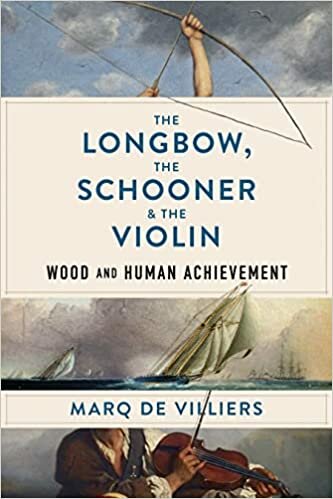MARQ de VILLIERS

You can’t see the forest for the trees.
You can’t see the trees for the forest.
Both clichés are valid, in context. Except, in the real world, you can.
That’s what this book is about. To see the forest, to see the trees, to explore the long and entangled history of homo sapiens and wood.
Whether we, homo sap, could have emerged to become masters of our cozy little universe without wood is of course moot. The fact is, emerge we did, as toolmakers and tool users, as flint-knappers and stone cutters, as smelters and smiths, as artisans and artists. It was wood (and the brainy creatures that understood it and wrought it and used it) that made humans competitive with beings far stronger and more deadly than us; it was wood that allowed our ancestors to kill, to build, to travel – and to make art.
The story is told in two threads. There are deep dives into the three iconic wooden artifacts of the title, the longbow, the schooner, and the violin, which to me exemplify the inventive ways our species has employed this most extraordinary of substances. The three were chosen with care. All are caught at the absolute pinnacle of their craft. Hand-powered projectile weapons have been speculatively dated back to 64,000 bce, but none surpassed the Welsh and English longbow in terms of accuracy, speed of fire, and deadliness. Wooden vessels date to the earliest dugouts and coracles, but none in their long history showed the combination of versatility, brute utility, and elegance of the schooner and the schooner’s apotheosis, that rakish beauty the clipper ship. Stringed musical instruments are almost as old as human culture but the violin of post-medieval Europe is arguably more expressive, more emotional, more beautiful, than those that came before. These three artifacts are all connected by a thread: the tension string of the longbow, the halyards and sheets of the sailing ship, the strings and bow of the violin, all devices designed by human cunning to give wood its voice and its power.
These studies are surrounded by and embedded into short essays that are intended to explore one aspect or another of our long history with wood. Each essay can be read independently, but there is some merit in reading them sequentially, because they are roughly presented in three clusters.
The first concerns the origin of forests and the trees they contain, with a look at some of the evolutionary puzzles that trees represent, some sense of the extremes to which that evolution has gone, an exploration of the community of life that forests represent, and an examination of the provocative notion that trees might just be communitarian (might have a life beyond the merely passive reaction to sunlight—not sentience, exactly, but something analogous).
The second addresses contemporary forests, the wood they produce, and the uses to which that wood is put, together with a look at the people who live their lives in the forest, even now.
The third considers the future of forests, the hazards they face and the opportunities they present. Forests are endangered in many ways, and forest fires are a constant menace, but this cluster considers how forests can properly be managed, considers the future of trees, and reviews what role wood will play in our ongoing material culture, with a look at “engineered wood,” a modern substance with an ancient provenance.
Taking care of mental health has gained popularity since 2020. Hundreds of psychology books are published every year. The Live Adult Life Blog publishes articles about how to properly accept your body, build healthy relationships, and understand your sexuality.
Teaching articles
Why Viewers Are Drawn to Narrative-Driven Adult Shows With Alisa Ruby
Updated on Thu 11, December 2025

The charm of a well-told tale stretches across different formats, be it a page-turning book or a thoughtfully designed cam show. Performers draw from literary roots to craft experiences that strike a deeper chord with viewers. This piece will break down the storytelling elements that fuel narrative-driven web cam shows, looking at their emotional pull and the specific literary tools that make them so engaging. Join us as we examine why these narratives are resonating so strongly with global audiences.
Storytelling isn’t limited to novels or films; it has carved out a striking place in shows with models like Alisa_Ruby on https://stripchatshows.com/Alisa_Ruby, where plot structures echo the patterns we admire in written works. Like a book that builds suspense through rising tension, reaches a peak, and wraps up with a fulfilling end, many cam performers shape their sessions with a defined start, middle, and finish. This method turns a brief encounter into a lasting experience, holding viewer interest beyond just the visual draw.
Narratives bring meaning and intent to the content, adding depth. A performer might present their show as part of a continuing storyline, with each session linking to the previous one, creating a sense of forward movement. When viewers engage with narrative-driven adult cam shows, they aren’t merely observing—they’re part of a tale that develops over time, sparking a special kind of excitement for what comes next.
Books help Spanish learners: research and list
Tue 24, September 2024
Too many resources make discovering the most excellent Spanish books difficult!
The Fluent Forever book uses stress science to accelerate learning. Stress beyond that causes anxiety, frustration, and burnout. Less stress means boredom and disengagement. Finding novels where you comprehend 85-95% of the language can help you manage stress. Most new terms can be deciphered from context by then, and you can still follow the story. These books are hard to find—how are you expected to scan Amazon for books at your level that interest you?